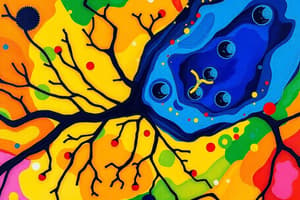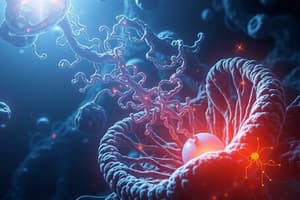Podcast
Questions and Answers
What are the three main parts of the inner mitochondrial membrane?
What are the three main parts of the inner mitochondrial membrane?
Boundary membranes, cristae, crista junction
What do mitochondrial membranes contain that is vital for oxidative phosphorylation?
What do mitochondrial membranes contain that is vital for oxidative phosphorylation?
- Nuclear DNA
- Transport proteins (correct)
- Electron transport proteins (correct)
- Ribosomes
Mitochondrial DNA (mtDNA) is circular like bacterial DNA.
Mitochondrial DNA (mtDNA) is circular like bacterial DNA.
True (A)
What is the primary function of NAD (Nicotinamide adenine dinucleotide) in cells?
What is the primary function of NAD (Nicotinamide adenine dinucleotide) in cells?
What is produced during glycolysis?
What is produced during glycolysis?
What cycle takes place in the mitochondrial matrix?
What cycle takes place in the mitochondrial matrix?
The process of ATP synthesis requires the ______ enzyme.
The process of ATP synthesis requires the ______ enzyme.
Mitochondria are static and do not change shape.
Mitochondria are static and do not change shape.
What is the main purpose of fission in mitochondria?
What is the main purpose of fission in mitochondria?
What high-energy molecule is produced primarily by aerobic respiration in mitochondria?
What high-energy molecule is produced primarily by aerobic respiration in mitochondria?
Match the following organs with their primary functions:
Match the following organs with their primary functions:
Flashcards are hidden until you start studying
Study Notes
Mitochondria Structure
- Mitochondria are organelles responsible for cellular respiration and ATP production.
- They have a double membrane structure:
- Outer membrane: Contains porins that allow small molecules to pass through.
- Inner membrane: Contains proteins for oxidative phosphorylation, including ATP synthase, electron transport proteins, and transport proteins.
- Intermembrane space: The space between the inner and outer membrane, continuous with the lumen of the cristae.
- Matrix: The central compartment inside the inner membrane, contains mitochondrial DNA (mtDNA).
Mitochondrial Membranes
- Inner membrane: Highly folded into cristae, which increase its surface area for ATP production.
- Cristae: Folding and tube-like invaginations of the inner membrane.
- Cristae junction: Sharp bends connecting the cristae with the boundary membrane.
- Outer membrane: Contains porins that allow small molecules to pass through when open.
Mitochondrial DNA (mtDNA)
- Located in the matrix.
- Circular DNA, similar to bacterial DNA.
- Codes for essential proteins for mitochondrial function, ribosomes, and transfer RNAs (tRNAs).
- Most mitochondrial proteins are encoded by nuclear DNA, synthesized in the cytosol, and transported to the mitochondria.
Mitochondria Dynamics
- Mitochondria are dynamic organelles, constantly changing shape, fusing, and dividing.
- Fusion: The merging of two mitochondria to form a larger one.
- Ensures homogeneity within the cell.
- Fission: The fragmentation of damaged or mutated mitochondrial parts.
- Facilitates cell division and allows for efficient transport to areas of high energy demand.
ATP Production
- ATP (adenosine triphosphate): The primary energy currency of the cell.
- Mitochondria are the main site of ATP production from glucose through aerobic respiration.
- Glucose oxidation: The breakdown of glucose into ATP occurs in four stages:
Glucose Oxidation Stages
- Glycolysis: Occurs in the cytosol, produces a small amount of ATP and NADH.
- Citric Acid Cycle (Krebs Cycle): Occurs in the mitochondrial matrix, produces NADH, FADH2, and some ATP.
- Electron Transport Chain: Located in the inner mitochondrial membrane, uses NADH and FADH2 to generate the proton-motive force (H+ gradient across the inner mitochondrial membrane).
- ATP Synthesis: Uses the proton-motive force to phosphorylate ADP into ATP via ATP synthase.
NAD (Nicotinamide Adenine Dinucleotide)
- Another energy molecule in the cell.
- Carries two electrons and a proton.
- Involved in oxidation/reduction reactions.
Glucose Metabolism
- Glucose: A six-carbon sugar, central to ATP production and cellular metabolism.
- Catabolic pathways: Break down molecules, such as glucose into smaller units.
- Anabolic pathways: Build larger molecules from smaller units.
- Glycolysis: The breakdown of glucose into two pyruvate molecules.
- Pyruvate: A three-carbon sugar that enters the citric acid cycle.
- Acetyl CoA: Derived from pyruvate, feeds into the citric acid cycle.
- Glucose can be:
- Broken down into sugars, fats, and phospholipids.
- Synthesized into glycogen (storage protein in animals).
- Used in nucleotide synthesis.
- Used to synthesize fatty acids, phospholipids, and fats.
- Used to synthesize amino acids.
Summary of ATP Production
-
Glycolysis: 2 ATP, 2 NADH
-
Citric Acid Cycle: 2 ATP, 6 NADH, 2 FADH2 (plus 2 NADH from pyruvate to Acetyl CoA conversion)
-
Total: 4 ATP, 10 NADH, 2 FADH2
-
Electron Transport Chain: Uses NADH and FADH2 to generate a proton gradient across the inner mitochondrial membrane.
-
ATP Synthase: Utilizes the proton gradient to phosphorylate ADP into ATP, producing a large amount of ATP.
Overall ATP Production
- Approximately 30-32 ATP molecules are produced per glucose molecule during aerobic respiration.
Studying That Suits You
Use AI to generate personalized quizzes and flashcards to suit your learning preferences.




